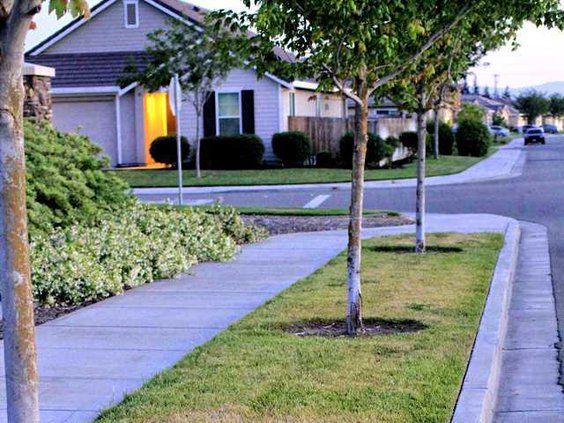Homes built in Manteca on corner lots after July 16 may not be able to have more than 25 percent of their side yards that are visible from the street planted in turf.
The Manteca Planning Commission Tuesday on a 3-2 vote added the restriction as part of the approval of a zoning code amendment limiting new homes to having no more than 25 percent of the required front yard landscaping planted in turf.
Commissioners Eric Hayes and Jeff Zellner cast the dissenting votes as they viewed the restrictions as government overreach. Hayes believes the city could pursue over options that would save more water and not essentially infringe on property rights. The matter now goes before the Manteca City Council on June 2.
“This may be the new reality,” city management analyst Johanna Ferreira said of the current water shortage. “We may have to rethink how we use water.”
She added if that isn’t the case, the city does not know when the current drought will end. She noted council members and staff “want to get ahead of it” so they don’t use water they could have saved if the drought continues or deepens.
Hayes inferred that the drought wasn’t impacting Manteca’s water supplies since it still can draft underground water while surface supplies from the South San Joaquin Irrigation District are being cutback 20 percent. He noted that the water level at his semi-rural home in western Manteca is five feet below the ground. Manteca’s drinking water, however, comes from an aquifer hundreds of feet down. The state also has put in place requirements that groundwater pumping be regulated and capped in future years.
Existing home are
grandfathered in
with two exceptions
At the same time the state has mandated Manteca cut back its water use from 2013 levels by 32 percent. And the biggest user of city water is landscaping that accounts for 60 percent of all water use between March and October. Ferreira noted that turf — grass that can be walked on and mowed low — is the single largest user of water in Manteca.
The commission debated the item for just under two hours with most concerns focusing on what a front yard is and whether the threshold for existing homes to be forced into compliance was too low.
All homes currently existing in Manteca would be grandfathered in and not subject to the limit on front and side yard turf unless the property was “not used” for six months as verified by utilities being turned off for that length of time or if more than 25 percent of the front yard landscaping was modified.
Allowing grass to die as now allowed by the city under an ordinance for the duration of the drought will not trigger the requirement that modifications be made.
Several commission members believed the threshold was too low for triggering existing homes opting to modify yards to comply with the 25 percent turf cap. They want the city to consider amending the zoning ordinance to change the triggering point from 25 percent to 50 percent of the front yard.
There was confusion as to why the city used two different terms to describe front yards as far as landscaping went — “actual front yard” and “required front yard.”
“Required front yards” are established by setback. That means if you are talking about a residential lot has a 20-foot setback the “required yard” goes to that point. The “actual yard” refers to the area in the front yard that’s created when the residential structure and garage are placed back further than the setback requires. The “actual yard” then refers to the front yard that starts at the edge of the sidewalk and goes to the first building whether it is the garage or the house.
Adding further confusion to the discussion was the staff explanation that the area behind the setback that is also behind the front profile of part of the house/garage structure that is closest to the street is not defined as part of the front yard and is not subject to any limitations on what can and can’t be done in terms of landscaping. Typically that occurs in newer homes where the garage is closer to the street than the front door or porch.
Street side corner yards don’t have to be landscaped under existing city rules. The change the commission recommended is if landscaping is placed in such side yards no more than 25 percent of it can be turf.
At the same time the 25 percent cap for front yard landscaping doesn’t mean that it has to be planted in any turf. The ordnance simply states that the 35 portent area of the front yard that is required to be landscaped must use living plant material.
LESS TURF FOR NEW HOMES
Grass being capped at 25% for corner side & front yards





